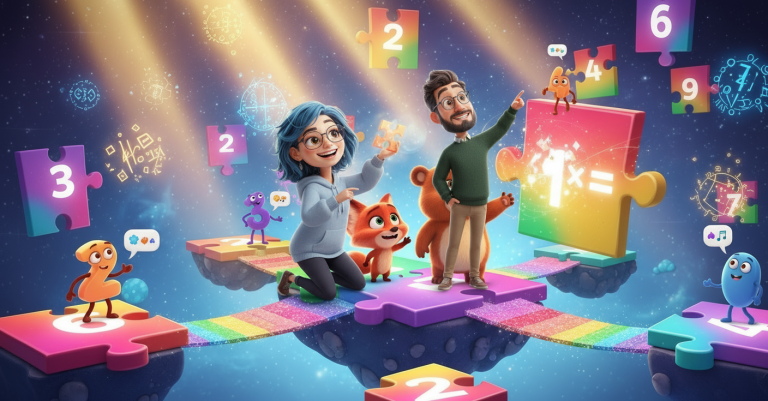The Amazing Secret of Impossible Puzzles
Have You Ever Been Tricked by a Puzzle?
Imagine you’re working on a sliding puzzle – you know, those square games with 15 numbered tiles and one empty space. You slide the pieces around, trying to get all the numbers in order from 1 to 15. But what if I told you something absolutely mind-blowing? Some of these puzzles can never, ever be solved!
That’s right! No matter how smart you are, no matter how many hours you spend sliding those tiles around, some puzzle arrangements are completely impossible to solve. It’s like trying to make water flow uphill or catch a rainbow in a jar – it just can’t be done!
The Great Puzzle Mystery
Back in 1874, a puzzle maker created these sliding puzzles and offered prize money to anyone who could solve certain arrangements. Lots of people tried and tried, but nobody could win the prize. Do you know why? Because some of those puzzles were secretly impossible!
It was like offering ice cream to anyone who could make their shadow solid. The puzzle maker didn’t mean to trick people – he just didn’t know about the mathematical secret hiding inside his game.
What Makes a Puzzle Impossible?
Here’s the amazing part: exactly half of all possible sliding puzzle arrangements are impossible to solve! If you randomly mixed up a sliding puzzle, you’d have a 50-50 chance of getting an impossible one. It’s like flipping a coin to see if your puzzle will work!
The Mathematical Detective Game
But here’s where it gets really cool – mathematicians figured out how to tell which puzzles are impossible without even trying to solve them! They’re like puzzle detectives with special mathematical magnifying glasses.
The secret involves counting something called inversions (that means “things in the wrong order”). An inversion happens when a bigger number comes before a smaller number. It’s like if you were lining up by height, but the tallest kid cut in front of the shortest kid!
The Empty Space Has Superpowers!
The empty space isn’t just sitting there doing nothing – it’s actually part of the mathematical mystery! The detectives also need to check where the empty space is sitting. Is it on an even row from the bottom or an odd row?
The empty space is like the conductor of an orchestra. It looks like it’s not playing music, but it’s actually controlling how everything else can move!
Two Mathematical Islands
Think of all possible puzzle arrangements as living on two different islands – the Solvable Island and the Impossible Island. Each island has exactly the same number of puzzle arrangements, and there are no bridges between them!
If your puzzle starts on Solvable Island, you can eventually reach the solved state by sliding tiles around. But if it starts on Impossible Island, you can slide tiles forever and never reach the solution. You’re stuck on the wrong island with no way to get across!
A Fun Detective Activity
Want to be a puzzle detective yourself? Here’s what you can do with a grown-up’s help:
- Look at your mixed-up puzzle
- Count how many numbers are “arguing” (bigger numbers in front of smaller ones)
- Check which row the empty space is on
- Use mathematical rules to predict if it’s solvable!
The Secret Connection to Everything
Here’s something that will make your brain sparkle: this simple sliding puzzle taught mathematicians about huge ideas! The same mathematical patterns show up in computer programs, physics experiments, and even how particles behave in space.
It’s like discovering that playing with blocks teaches you how to build skyscrapers, or that understanding hopscotch helps you become a rocket scientist!
Group Theory – The Rules of Rearranging
Group theory (that means “studying how things can be moved and combined”) is like being a super-organized toy expert. It figures out all the possible ways to arrange your toy collection and which arrangements you can reach from others.
The sliding puzzle showed mathematicians that not all arrangements are connected to each other. Some live on separate mathematical islands with no bridges between them!
Impossibility is a Superpower
Here’s the most beautiful part of this whole mystery: impossibility isn’t disappointing – it’s actually a mathematical superpower! When we discover what’s impossible, we learn about the secret rules that control how our world works.
It’s like impossibility reveals the hidden architecture of reality. Instead of being sad that some puzzles can’t be solved, we get excited because impossible things teach us amazing mathematical truths!
Impossible Things Are Everywhere!
Once you start looking, you’ll find impossible things hiding all around you:
- Some knots can never be untied, no matter how hard you try
- Some mathematical equations have no solutions
- Some shapes can’t be folded in certain ways
- Even your breakfast cereal has mathematical secrets!
The Amazing Web of Mathematics
Mathematics is like a giant spider web where everything connects to everything else. When you pull on one thread (like wondering about a sliding puzzle), you discover connections you never imagined!
That simple 15-piece puzzle connects to advanced computer science, physics, and even how scientists understand the universe. It’s like finding out that tic-tac-toe holds the secrets of the cosmos!
Every Day is Full of Mathematical Adventures
The coolest thing is that you don’t need fancy equipment to be a mathematical explorer. All you need is:
- Curiosity – wondering about how things work
- Questions – asking “what if” and “why”
- Wonder – being amazed by the world around you
What Mathematical Mysteries Will You Discover?
Now that you know about impossible puzzles, what other mathematical secrets might be hiding in plain sight? Maybe in your toys, your games, or even the way your socks are arranged in your drawer!
Every impossibility is like a clue waiting to be decoded. Every simple question might lead to an amazing discovery. Who knows? Maybe you’ll invent the next great impossible puzzle or discover a new mathematical island!
Your Thoughts Are Mathematical Treasures
Remember, when something seems impossible, it might be teaching you about the most beautiful mathematical truths. Your curious mind is like a treasure detector that can find hidden mathematical gems everywhere you look.
So keep wondering, keep questioning, and keep discovering the mathematical magic that’s all around you. Every day is a new adventure when you have the eyes of a mathematical detective!













